Lord Jagannath Rath Yatra: “The World’s Largest Chariot Festival”
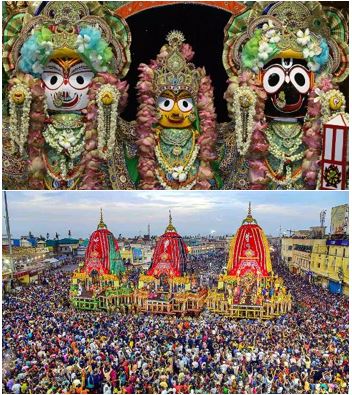

In the book “A History of Orissa”, historian Sir W.W. Hunter describes the Jagannath Rath Yatra as ‘Music Strikes Up Before And Behind, Drums Beat, Cymbals Clash, The Priest’s Harangue From The Cars . . . The Dense Mass Struggles Forward By Convulsive Jerks, Tugging And Sweating, Shouting And Jumping, Singing And Praying And Swearing . . .’Such magnificent is Jagannath Rath Yatra of “Lord Jagannath”.
Rath Yatra also known as the Festival of Chariots, is one of the world’s oldest religious festivals, originally celebrated in Jagannath Puri. For the last hundreds of years, millions of devotees gather in the Indian Ocean city of Puri every year to attend Lord’s Jagannath Rath Yatra. This centuries-old chariot procession is not only a religious ritual but also a brand showcase of how the Jagannath consciousness has long enriched the cultural heritage of the Indian state of Odisha. The Gotipua dance performance which is an integral part of the festivities makes Lord’s yatra much more splendid.
Although the biggest processions take place in the city of Puri, the eastern state of Orissa, the other bigger procession takes place in the western state of Gujarat.
The Festival of Chariots marks the annual ceremonial procession of “Lord Jagannath”, his elder brother “Baladeva” and younger sister “Subhadra”, from their home temple to another temple, located in what is their aunt’s home.
Lord’s Jagannath Rath Yatra is held during the Hindu month of “Ashadha” (June–July, in the Gregorian calendar) in “Purushottam Khstra” (as Puri was once known).

In the Brahmanda Purana, it is said, “A person who sees the Lord’s Rath Yatra (Chariot festival) and then stands up to receive the Lord can purge all kinds of sinful results from his body.”
In the Bhavishya Purana, it is said, “Even if born in a poor family, a person who follows the Rath Yatra cart when the Deities pass in front or from behind will surely be elevated to the position of achieving equal opulence with Vishnu.”
Rath yatra comprises “Lord Jagannatha”, his older brother “Balarama also called Baladeva” and younger sister “Subhadra”.
“Jagat” means “The moving world” and Nath means “The Lord”, so, “Jagannath” means “The Lord of the Universe”.
Hindu scriptures mention Jagat or World as “Gacchati Iti Jagat”.
In the material world, everything is moving. The planets are moving; the Sun is moving; even the Trees that stand still are continuously moving. The living entities are also transmigrating from one species of life to another. In that sense also there is constant movement. Thus, this material world is called “Jagat” and the Supreme Lord is “Jagannatha” – the proprietor of all these movements.
The brother Balarama, “Bala” means “Strength” and “Rama” means “Enjoyment”. Baladeva or Balarama gives us spiritual strength for enjoying eternal blissful life.
And then Sister Subhadra, “Su” means “Auspiciousness” and “Bhadra” means “Well-being”.
Subhadra, Jagannatha, and Balarama combined together are present before us to reclaim us all from the miserable conditions of life. It is said in holy scriptures that “If anyone sees on the cart Jagannatha, Balarama, and Subhadra, then he does not take birth again in this material world”.
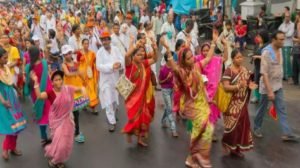
This is the only festival in the world where deities are taken out of temples to travel to devotees, and also the largest chariot procession in the world.
Millions of people witnessed “King” sweeps the road with a golden mop and three massive 18-wheeled chariots bearing the sibling deities make their way through massive crowds. Their chariots, which are mini architectural marvels, are constructed over 42 days from over 4,000 pieces of wood by the only family that are creating the chariots for centuries.
Legend says it always rains on the day of the procession. For a whole week before, the temple doors are shut and no one is allowed inside, as it is believed that the sibling deities have a fever after bathing in the sun with 108 pitchers of water. The breaking of their fever calls for a change of scene, which is why they go to their aunt’s home for a few days.
Unlike the ornate, carefully crafted metal idols everywhere else, these three deities are fashioned from wood, cloth, and resin. They are malformed with large heads and no arms: reminders of the legend of an impatient King.
The local community has many anecdotes about Lord Yatra.
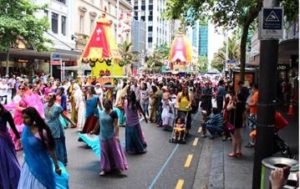
One speaks of an arrogant Indrayumna, King of Puri in the east, who tried to steal the Hindu god Krishna’s heart. It had been immersed in the legendary Dwarka sea after his cremation and had reappeared to the tribe people of the place as an idol. When Indrayumna tried to claim its possession, the idol disappeared. The repentant king sought absolution from Krishna by sanctifying him in another form.
Three deities are fashioned from wood, cloth, and resin
Another speaks of how Krishna’s grief-struck siblings – his elder brother Balarama and younger sister Subhadra- rushed into the Dwarka sea carrying his half-cremated body. At that exact moment, King Indrayumna dreamed that Krishna’s body had floated back up on his shores as a log.
The two scriptural stories merge here: Indrayumna decided to build a temple to house the log. His next task was to find someone to craft the idols from it. It’s said that Vishwakarma, God’s own architect, arrived as an old carpenter. He agreed to carve the idols, but on the condition that he was not to be disturbed. However, when he did not emerge from his workshop for weeks, going without food, water, or rest, a worried and impatient King threw the door open
At the time the images were only half-finished, but the carpenter disappeared. Still, believing the idols to be made from the very body of God, the King sanctified them and placed them in the temple[1].
When the deities disintegrate, they are remade in the same half-done image with new wood every 12 years. They were last remade in 2015.

Lord’s Jagannath Rath Yatra has long enriched the cultural heritage of Odisha—in terms of its art, architecture, literature, music, and dance. And this influence is reflected in the artistic offerings that form a part of this ritualistic procession, as devotees offer their services aka Seva through performing arts, such as “Telengi Baja” (rhythmic beating of gongs), “Banati Khela” (acrobatics), “Nagara Kirtan” (public singing and dancing).
The three divine siblings go on their annual sojourn to the Gundicha temple—their ancestral home—accompanied by an ecstatic crowd on “Bada Danda”, the stretch of road leading to the twelfth-century shrine
During the Rath Yatra, Gotipua’s performance is incredible and it forms a part of this frenzied procession.
“Gotipua”, literally meaning “Single Boy”, is a temple dancing tradition kept alive by young male dancers and has heavily influenced the modern-day classical dance, Odissi. Gotipuas perform on the verses of the Gita Govinda, a twelfth-century Sanskrit work written by poet Jayadev depicting the relationship of Radha and Krishna. What appeals most to the audience are the graceful movements of the dancers, the acrobatics, and the formation of human pyramids[2].
Gotipuas very successfully manage to hold the attention of the audience with their famous Bandha Nritya, a type of acrobatic dance (bandha, in Odiya, means limbs).
To master the style, the boys start training as young as four-five in akharas to be able to enact the postures from the mythological scenes based on the life of Krishna as mentioned in the seventeenth-century manuscript “Abhinaya Chandrika”. Young girls are also often seen dancing dazzling.
As per Hindu scriptures, Dwarka in Gujarat is the place where Krishna’s half-cremated body is immersed in the ocean. Dwarka, Gujarat is located on the west coast of India, and Puri, Orissa where it is said to have re-emerged as a log – is located on the east coast of India.
About 500 hundred years ago, a Hindu saint and temple priest of a “Hanuman Temple” in Gujarat, Shree Sarang Das Ji, arrived in Puri to offer prayers at the Lord Jagannath temple.
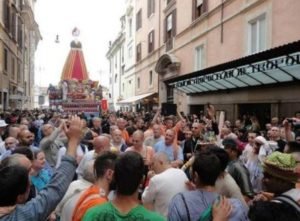
While sleeping at the temple guest house, it is believed that he received visionary instruction from Lord Jagannath to go back to Ahmedabad in Gujarat and install three idols of Jagannath, Baladeva, and Subhadra there. Carrying out the instructions received in his dream, he founded the “Ahmedabad Lord Jagannath Temple”.
By doing so, he sanctified the two locations – one where Krishna’s mortal remains began their journey from the west, to their transformation as Puri’s Lord Jagannath in the east.
About 142 years ago, one of the founder’s disciples, Shree Narsimha Das Ji Maharaj, began the “Ahmedabad Rath Yatra”. The deities on chariots, pulled by elephants and humans, replicate their own journey in Puri, completing a set of rituals that sanctify the two places where Krishna’s mortal remains are believed to have come to rest.
Apart from being celebrated originally at the majestic city of Puri in Odisha, here’s a list of the iconic cities outside India where the festival of Rath Jatra is observed gallantly.
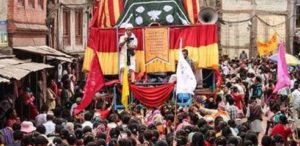
Rath Yatra in Nepal is spectacularly celebrated in the city of Bhaktapur. One can even visit the Jagannath temple in Kathmandu which miraculously survived the massive 2015 earthquake.
Lord Jagannath rath yatra was started in the newly constructed center of Medan, Indonesia. In Bali also Lord rath yatra fills the air with spirituality.
Every year on Jagannath Rath Yatra, the streets of the Czech capital, Prague is dotted with devotees who are seen pulling a 40-foot-high chariot carrying the idols of Lord Jagannath, Baladeva, and Subhadra. The crowd is also ardently followed by a procession of singers, musicians, and dancers who revel in the festivity all along.
Even Italian devotees are no less in thronging and dancing down the streets in adoration of the Lord. It was way back in 1981 in the Tuscan town of Viareggio when the first Rath Yatra in Italy was held.
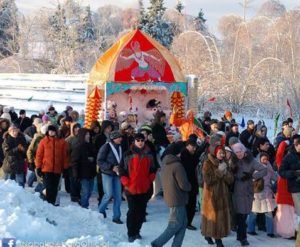
There is always a splendid view of Rath Yatra observance in Moscow wherein nearly hundreds of Russian devotees braved the severe 20 below zero weather and snowfall to pull the deities blissfully. Truly a sight to behold.
The famous Trafalgar Square is filled with vibrant colors of chariots as huge crowds gather every year to blissfully celebrate Rath Yatra.
Almost 49 years ago in 1967, the first Rath Yatra outside India was celebrated in the city of San Francisco. Interestingly, until today, the people of this city rejoice in the festivity with utmost grandeur.
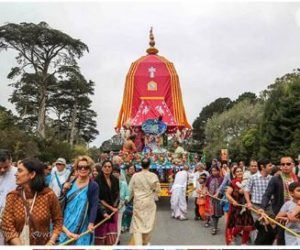
New York has witnessed 47 Rath Yatra in a row expect the Pandemic year of 2020. New York Rath Yatra parade always starts at 11:00 am from 45th Street and Fifth Avenue, and will make its way down Fifth Avenue to Washington Square, where a festival will be taking place from noon till seven o’clock. The energy and enthusiasm of the devotees during the 2-mile-long yatra are hardly mentioned. Thousand of devotees gather and recite Krishna’s name during the walk.
It’s thrilling to view the colorful & decorative chariots being pulled through the beautiful beaches of Florida on the auspicious day of Rath Yatra. With classical dance & music centering on the chariots, the feel of this festivity gets elevated all the more.
Rath Yatra firstly embraced the Durban shoreline in 1988 and is celebrated vibrantly ever since. Infact, besides the usual chariot parade, many other cultural activities featuring local & international artists grace this spiritual day.
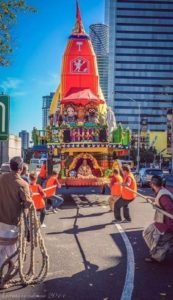
Amidst colorful singing & merrymaking, the occasion of Rath Yatra is honored in the beautiful city of Brisbane. And the cultural fiesta which ends up with this jubilant street procession is worth witnessing.
Rath Yatra is also famously celebrated in the beautiful city of Auckland. True to its fame, the devotees’ dance in front of the chariots takes place with full fervor.
Hundreds of Lord Jagannath Rath Yatra processions happened in the world. Few to mention are Toronto (Canada), Madrid (Spain), Parsippany, NJ (USA), Los Angeles, CA(USA) and the list is endless…
Lord Jagannath Rath Yatra is so splendid, big, and spiritual that the English dictionary has discovered the new word “Juggernaut” for the Lord’s yatra.
My fellow devotees, Let’s recite Lord’s Name with his beautiful mantra
Hare Rama Hare Rama Rama Rama Hare Hare
Hare Krishna Hare Krishna Krishna Krishna Hare Hare
[1] Rath Yatra: The legend behind world’s largest chariot festival – BBC News
[2] Rath Yatra, Gotipua and Salabega Connection | Sahapedia
DISCLAIMER: The author is solely responsible for the views expressed in this article. The author carries the responsibility for citing and/or licensing of images utilized within the text.
